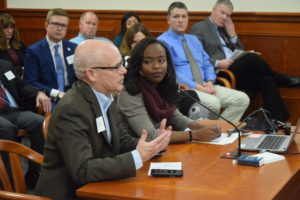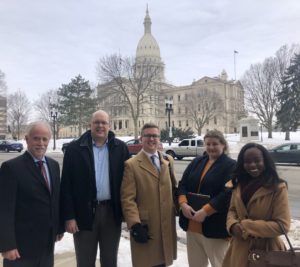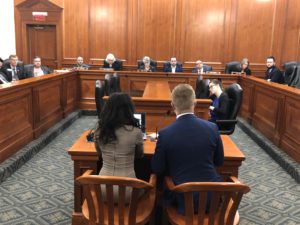
Grand Haven City Manager Pat McGinnis testifies with the Michigan Municipal League’s Herasanna Richards about the impact of high water levels on his city.
Officials from several Michigan communities testified in a House subcommittee Thursday, January 23, about the devastating impact of shoreline erosion and high waters. A related report given by Michigan’s Department of Environment, Great Lakes and Energy (EGLE) predicted little relief is in sight as water levels are expected to get even higher this year.
The Michigan Municipal League requested Thursday’s hearing before the House Appropriation Sub-Committee on Natural Resources and Environmental Quality to talk about the high water levels and the costly impact it’s having on Michigan community infrastructure.
League Legislative Advocate Herasanna Richards led the charge testifying on the issue along with officials from five League-member communities – Grand Haven City Manager Pat McGinnis; Ludington City Manager Mitch Foster; Grosse Pointe City Manager Pete Dame; Rogers City Mayor Scott McLennan; and Kate Hosier, South Haven assistant city manager and harbormaster. Pentwater Village Manager Chris Brown also attended in support of the effort. Two members of the Michigan Association of Counties also testified at the hearing about the impact of high lake levels.

From right: League Legislative Advocate Herasanna Richards; Kate Hosier, South Haven assistant city manager and harbormaster; Ludington City Manager Mitch Foster; Grosse Pointe City Manager Pete Dame; and Rogers City Mayor Scott McLennan. The group all testified on the high water levels issue.
“We won’t have much of a beach this summer. We’re telling people to plan on getting your feet wet if you come here,” said Pat McGinnis, city manager of Grand Haven, which sits on the shores of Lake Michigan. “We had to close a public building because of mold issues from the higher water. We’re shutting them down and tearing them down and there is no insurance coverage.”
Kate Hosier, assistant city manager for South Haven, said there are serious worries in the city about the wastewater treatment system backing up and the loss of tourism in the Lake Michigan beach town.
“The economic impact is severely understated. We’re a tourist town, and if no one comes to our beaches, we’re seeing a majority of people not being able to come into town,” she said. “We’ve had streets underwater where citizens can’t get to their homes and the river overrunning its banks. If the lake levels go up another foot, we’re going to be in dire straits.”
Mitchell Foster, city manager in Ludington, said the waves continue to swamp the city’s breakwall and flooding routinely closes a key intersection in the town.
“Our water treatment facility has lost more than 100 feet of dune in front of it and that could mean millions of dollars in addition to what we’ve already put into it,” he said, noting that some creative solutions have to be developed. “What kind of infrastructure are we going to put in that’s not going to be a waste of time and money in four years,” when the water levels recede again.
In Grosse Pointe, city manager Peter Dame said it’s not just a problem for the Great Lakes. Communities along the Detroit River and Lake St. Clair are also suffering. The Connor Creek sewage treatment plant, which is only supposed to deal with storm water overflow, was running all summer.
“The biggest potential problem is that Lake Shore Drive, which is actually Jefferson, is a county-owned road and it’s become severely eroded. It will cost $8 million to $12 million to fix the seawall,” he said. “ Grosse Pointe Shores checked out a sinkhole in Lake Shore Drive for what they thought was a leaking sewer pipe, but the lake was actually running under the road.”
Much farther north in Rogers City, on the shores of Lake Huron, the breakwall at the city’s marina has had to be barricaded off, a city park has been destroyed and two of four deep-water wells that service the city are now within 10 feet of the water line, said Mayor Scott McLennan.
“Our beaches are so important to us, but our beaches are pretty much gone at this point,” he said. “The Michigan Department of Transportation is doing emergency repairs on US-23 just north of the city. The bike trail that ran along US-23 was impacted and now, US-23 is at risk of being deluged by wave action.
“I don’t know what the answer is, but we don’t have the funds to make all of those repairs,” he added. “It will be hundreds of thousands of dollars.”
The League will continue these conversations at the Michigan High Water Coordinating Summit, hosted by EGLE and Gov. Gretchen Whitmer on Feb. 10 in Lansing. This convening will engage local units of government through their statewide associations to analyze the issue and discuss collaborative steps towards a solution. We will keep you engaged in any updates.
Herasanna Richards is a legislative associate handling energy, environmental, elections, and external municipal services for the League. She can be reached at hrichards@mml.org or 517-908-0309.






